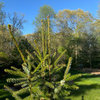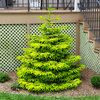Raising soil level
karinl
16 years ago
Related Stories

GARDENING GUIDESGrow a Beautiful Garden in Alkaline Soil
Got alkaline soil? Learn how to manage it and the many beautiful plants that will thrive in this ‘sweet’ soil
Full Story
GARDENING GUIDESGardening Solutions for Heavy Clay Soils
What’s a gardener to do with soil that’s easily compacted and has poor drainage? Find out here
Full Story
GARDENING GUIDESThe Poop Scoop: Enrich Your Soil With Good Old Manure
Get over the ick factor already — this natural super-ingredient for soil has so many benefits, you'll wonder why you ever went chemical
Full Story
FARM YOUR YARDHow to Get Good Soil for Your Edible Garden
The nutrients in your soil feed the plants that feed you. Here are tips on getting it right — just in time for planting season
Full Story
GARDENING AND LANDSCAPINGBuild a Raised Bed to Elevate Your Garden
A bounty of homegrown vegetables is easier than you think with a DIY raised garden bed to house just the right mix of soils
Full Story
GARDENING GUIDES10 Solutions for Soggy Soil
If a too-wet garden is raining on your parade, try these water-loving plants and other ideas for handling all of that H2O
Full Story
GARDENING GUIDESGet the Dirt on Your Garden’s Soil
Understand how your soil supports your plants so you can ensure your garden’s success
Full Story
LANDSCAPE DESIGNHow to Shape a Rain Garden and Create the Right Soil for It
Learn how to grade, lay out and amend the soil in your rain garden to support your plants
Full Story
CONTAINER GARDENSContainer Gardening Basics: The Dirt on Soil
Learn the types of potting soil available and the best mixes to help your containers thrive
Full Story
GARDENING GUIDESHow to Stop Worrying and Start Loving Clay Soil
Clay has many more benefits than you might imagine
Full StorySponsored
Franklin County's Full Service, Turn-Key Construction & Design Company
More Discussions









ken_adrian Adrian MI cold Z5
pineresin
Related Professionals
Belmont Landscape Architects & Landscape Designers · Camas Landscape Architects & Landscape Designers · Carson Landscape Architects & Landscape Designers · Oconomowoc Landscape Architects & Landscape Designers · Jackson Landscape Contractors · Milford Landscape Contractors · Aloha Landscape Contractors · Belmont Landscape Contractors · Cordele Landscape Contractors · Mission Bend Landscape Contractors · South Lyon Landscape Contractors · Wanaque Landscape Contractors · Weslaco Landscape Contractors · West Chester Landscape Contractors · Kingsburg Landscape ContractorskarinlOriginal Author
ken_adrian Adrian MI cold Z5
Embothrium
karinlOriginal Author